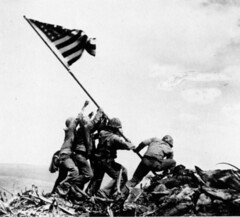 Image by luvi via Flickr
Image by luvi via FlickrNot bad for a backup plan.
The flag immortalized in Joe Rosenthal's famous photograph was the second US flag raised atop Mt. Suribachi during the Battle of Iwo Jima. Another US flag had been raised a short time earlier, one that the rather more famous (and larger) US flag was brought in to replace.
What happened to the first US flag raised atop Mt. Suribachi during the battle of Iwo Jima?
The first US Flag raised atop Mt. Suribachi during the battle of Iwo Jima was returned (temporarily) to the 2nd Battalion, 3rd US Marine Division -- the company that supplied the flag in the first place. The reasons why that flag was replaced, and how the replacement was subsequently captured in one of the greatest war photos ever taken, represent an amusing if oft-overlooked footnote in World War II history.
US Armed forces, composed largely of US Marines, captured Mt. Suribachi on the morning of Feb. 23, 1945. 2nd Marines Battalion Commander Chandler Smith oversaw the forces that took the position, and he provided one of his lead patrol officers with a US flag and the orders, "if you get to the top, put it up." At roughly 10:20 am local time Staff Seageant James Lowery, a photographer for Leatherneck magazine, snapped a pic of the first US flag raised over Iwo Jima.
Amazingly enough, the sitting US Secretary of the Navy James Forrestal was present at the Battle of Iwo Jima and witnessed from a distance the first flag-raising atop Suribachi. Forrestal was so inspired by the sight of Marines erecting a flag atop a contested Japanese position that he requested the flag be returned to him as a memento of the historic event.
Colonel Smith, perhaps insubordinately, flat-out refused Forrestal's request, considering the first flag raised over Iwo Jima to be the property of his Marine battalion. Colonel Smith thus ordered the first flag lowered and returned to his staff, and a second flag raised atop Mt. Suribachi so that the substitute flag could be sent to Secretary Forrestal. It was the second, larger flag that was photographed by Joe Rosenthal -- where the image was quickly circulated to wire services and appeared in Allied newspapers the world over within 18 hours.
Thus, Forrestal never got his souvenir -- the Iwo Jima flag was too famous for even a cabinet secretary to keep. Of course, Colonel Smith was thwarted as well. Both the first and second US flags raised over Iwo Jima were turned over to the National Museum of the Marine Corps, preserved as artifacts of military courage, US history and -- naturally -- the Truly Trivial.
